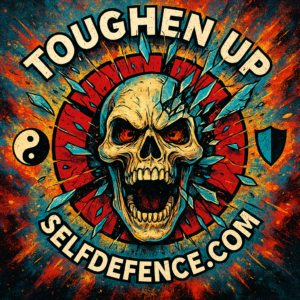Welcome to Toughen Up Self-Defence
A Practical System for Real-World Personal Safety
Most people don’t think much about personal safety—until they have to. But by then, it’s usually too late to do much about it. When things turn dangerous, uncertainty and hesitation can cost you. Toughen Up Self-Defence gives everyday people a clear, structured system for reducing vulnerability and improving response under pressure.
This program is designed for people who want to be ready. Whether you’re dealing with unknown risks on the job or simply want to protect yourself and your family, this approach teaches the mindset, habits, and physical skills that matter when it counts.

The Seven Components Framework
The foundation of this system is a paradigm called The Seven Components of Self-Defence. It’s a holistic approach that organizes what I believe, after 50 years of studying, training and teaching this stuff, is true and useful about all things self-defence and personal safety into seven categories—each one addressing a distinct element of preparation and performance.
The aim is to take the confusion out of self-defence by clearly defining the major areas that need to be addressed. Rather than treating violence as a single event or relying on technique-based training alone, this model views personal safety as a layered process that spans from pre-incident awareness to post-incident recovery.
Each component serves a specific purpose and reinforces the others. The result is a system that’s teachable, adaptable, and grounded in lived experience. It gives individuals and instructors a reliable structure to work from, without getting lost in overcomplication or false confidence.
What is “Successful Self-Defence?”
I’ve said for many years:
How you define success determines the path you take to achieve it.
Many self-defence instructors and enthusiasts define “self-defence success” as defeating or fighting off an attacker. As a result, their approach to self-defence training is limited to physical skills; a crash course in martial arts, if you will. I don’t think of it that way. I consider the “gold standard” of self-defence success to be when nothing happens!
Sure, you need to hope for the best and plan for the worst; physical skills and combative tactics are part of the puzzle, but they are the last resort, not the first. If you find yourself having to fight your way out of a bad situation, there’s a very good chance that mistakes and omissions were made leading up to it.
“By failing to prepare, you are preparing to fail.” – Benjamin Franklin
Together, these components provide a clear, structured way to study, apply, and teach personal safety across a wide range of scenarios. It’s built around seven critical components. Each one covers a different aspect of preparation, assessment and performance. Together, they form a complete, teachable structure:
1. Combative Training
Survival motor learning is learning legitimate combative skills that are simple, easy to learn and can be acquired as quickly as possible. These include
effective physical skills that can be performed under stress. The focus is on a few key actions you can trust and perform under stress. The goal is capability under pressure—not accumulation of moves.
Combative and martial arts moves can also be incorporated into ongoing training for health, resilience and physical preparedness. I cover that in detail on my companion website at ToughenUp.com.
2. Self-Defence Intelligence
Awareness, recognition, and rapid decision-making. This includes the ability to read situations in real time, detect early warning signs, and assess what’s likely to happen next.
3. Response Strategies
You’ll learn to apply and shift between core options: compliance, escape, de-escalation, defiance, or physical action. Not every situation calls for the same response. This component helps you make sound choices based on the reality in front of you.
4. Prevention
Proactive habits, preparation, and positioning. Many incidents can be avoided entirely by recognizing risks early, adjusting your behaviour, and controlling your environment. Prevention isn’t passive. It’s a skill.
5. Predatory Recognition
Understand the behaviour patterns and cues that reveal when someone is testing or preparing for an assault. By learning how offenders operate, you become harder to target.
6. Victim Selection
Predators seek out people they think won’t resist. This section teaches how to carry yourself in a way that communicates awareness and readiness—without bluff, bravado, or aggression.
7. Survival Psychology
Knowing what to do isn’t enough. You need to be able to function when adrenaline spikes, fear kicks in, and your thinking narrows. This component addresses the physiological and psychological realities of high-stress performance.
Why This System Works
Many people freeze, panic or react poorly in high-stress situations—not because they lack courage, but because they’ve never trained their mind and body to handle it. This program addresses that gap.
What’s taught here isn’t complicated. It’s been refined over decades of instruction, field experience, and incident analysis. It’s practical, adaptable, and designed for implementation.
You don’t need a background in martial arts, law enforcement, or security. You need a system you can learn, apply, and trust.
What It Prepares You For

- Making faster, more accurate decisions under pressure
- Detecting threats early and preventing escalation
- Responding effectively with legally and ethically defensible actions
- Recovering physically and mentally after a critical incident
Take the Next Step
If you want to build real capability—not just collect techniques or talk about scenarios—this system gives you a way forward. It’s grounded, structured, and built for real people living in a world where the unexpected can happen.
Start where you are. Build what you need.
